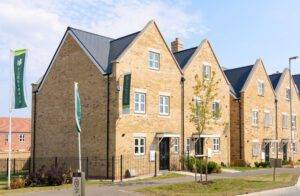<?xml encoding=”utf-8″ ?????????>
The number of people purchasing properties before they are built has plummeted to its lowest level in over a decade, driven by higher mortgage rates and the end of government support for first-time buyers.
Experts attribute the decline in off-plan purchases to higher interest rates, which have pushed first-time buyers towards more affordable, second-hand homes. The end of the Government’s Help to Buy scheme has also played a significant role.
Research by estate agency Hamptons reveals that only 32% of new homes sold in England and Wales were bought before completion, a stark contrast to nearly half eight years ago. Off-plan purchasing, which typically involves buyers reserving a plot based on marketing materials and floor plans, has sharply declined.
Home movers have also shied away from off-plan purchases, with only 22% of detached homes and 31% of semi-detached homes sold before completion in 2023. The peak of off-plan sales was in 2016 at 47%, driven by investors rushing to beat the 3% stamp duty surcharge on second homes. Since then, landlords have become a smaller share of purchasers, contributing to the decline in off-plan sales, except for a brief uptick in 2021.
Interest from both British and overseas buy-to-let investors has waned due to uncertainty over rental reforms and recent tax relief cuts. For the first time since the pandemic, flats are now more likely to be sold off-plan than terraced houses.
Rico Wojtulewicz, spokesman for the National Federation of Housebuilders, confirmed the reduction in off-plan transactions. “The sales are down and that is a real problem for the big developers. The buying process is so slow,” he said. He added that large sites depend on quick off-plan sales to progress through development phases.
David Fell of Hamptons noted that higher mortgage rates have deterred sales. “Higher mortgage rates have introduced a new barrier in the form of unaffordable repayments and have pushed buyers towards smaller, more affordable homes that are often second-hand,” he explained. Housebuilders have responded by slowing their build rates, with major builder Persimmon reducing output by 33% last year.
“Off-plan sales are the foundation of most housebuilders’ businesses – selling fewer homes before they’re built is bad news for their bottom line,” Fell said. With more homes sold only after completion, developers are borrowing money for longer and at higher interest rates, prompting them to slow build rates to preserve capital.
Regional disparities in off-plan demand are evident, with the East of England having the lowest at 25%, while London remains the highest at 47%, though still at its lowest since 2012.
The Help to Buy equity loan scheme, which helped 350,000 people onto the housing ladder, was a key driver of new-build purchases in recent years. The scheme allowed first-time buyers to purchase a new-build home with a 5% deposit and a 20% Government-backed equity loan, or 40% in London, but closed to new applicants in October 2022.
High mortgage rates have further dampened interest in new builds. The average two-year fixed mortgage peaked at 6.85% last August and now stands at 5.91%, according to Moneyfacts. New builds also typically command a higher price, with last year’s new build premium averaging 13%.
The Competition and Markets Authority (CMA) has launched a review into the house building sector over concerns of shared commercially sensitive information and other issues, including poorly built properties, excessive fees, and inescapable management schemes. The CMA calls for a structural overhaul of the sector, which it cannot achieve alone.
David Fell concluded, “The Government is unlikely to get close to hitting its house-building targets until interest rates drop back considerably and demand picks up.” Last year, Britain built 234,000 new homes, falling short of the Government’s 300,000 per year target. Outgoing housing secretary Michael Gove has since made these targets advisory rather than compulsory.

























